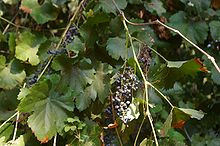Vitis californica, with common names California wild grape, Northern California grape, and Pacific grape,[1] is a wild grape species widespread across much of California as well as southwestern Oregon.[2][3][4]
| Vitis californica | |
|---|---|

| |
| Scientific classification | |
| Kingdom: | Plantae |
| Clade: | Tracheophytes |
| Clade: | Angiosperms |
| Clade: | Eudicots |
| Clade: | Rosids |
| Order: | Vitales |
| Family: | Vitaceae |
| Genus: | Vitis |
| Species: | V. californica
|
| Binomial name | |
| Vitis californica | |
The California wild grape grows in canyons, alongside springs, streams. It tends to thrive in damp conditions and so it is common in riparian areas.[5] It can be found on slopes as well as flat ground in wetland and forested habitats. Once matured[5] like most other native California plants it can withstand periods of dry conditions.[6]
Description
editVitis californica is a deciduous vine distributed along the Coast Ranges from Douglas County, Oregon, south to San Luis Obispo County, California; in the Klamath Mountains, the Cascade Range, and the Sierra Nevada from Siskiyou to Kern counties, California; and in the Central Valley.[7] It is fast growing and it can grow to over 10 m (33 ft) in length.[8] It climbs on other plants or covers the ground with twisted, woody ropes of vine covered in green leaves. In the fall the leaves turn many shades of orange and yellow before losing its leaves then in the spring it flowers typically in May and June.[4]
Bunches of small and often sour but edible purple grapes hang from the vines in autumn, which can be made into wine or jelly.[9] The grapes provide an important food source for a variety of wild animals, especially birds, and the foliage provides thick cover. The grapes are a common sight along the banks of the Sacramento River.
Cultivation
editViticulture
editThe wild grape is strong and robust, and viticulturists worldwide often use it as rootstock for their wine grapes.[10] It prefers heavier soils.[8] In some areas where the plant is not native it has the capacity to become a noxious weed. However, its invasive nature can be kept under control and is very easy to pull out.[8]
Horticulture
editVitis californica is cultivated as an ornamental plant. The interesting shape and color of the leaves and the lush, trainable vines make this species an attractive garden plant. This vine is commonly used in native plant gardens, where once established it thrives without summer water.
The cultivar 'Roger's Red' (named for noted horticulturist Roger Raiche) turns brilliant red in fall.[11] It is a hybrid with a wine grape, × Vitis vinifera cv. Alicante Bouschet.[11] The cultivar 'Walker Ridge' turns yellow in the autumn.[12]
References
edit- ^ "Vitis californica". Germplasm Resources Information Network. Agricultural Research Service, United States Department of Agriculture. Retrieved 7 July 2015.
- ^ Jepson Flora: Vitis californica
- ^ Biota of North America Program 2014 county distribution map
- ^ a b Calflora taxon report, Vitis californica Benth. California grape, California wild grape
- ^ a b Smither-Kopperl, Margaret (June 2022). "Plant Guide for California wild grape (Vitis californica)" (PDF). USDA-Natural Resources Conservation Service. Retrieved 2022-10-01.
- ^ "Plant Details - Kumeyaay Garden". University of San Diego. Retrieved 2022-10-18.
- ^ Howard, Janet L. (1993). "Vitis californica In: Fire Effects Information System". U.S. Department of Agriculture, Forest Service. Retrieved 2022-10-01.
- ^ a b c "California Grape, Vitis californica". Calscape, California Native Plant Society. Retrieved 2022-10-01.
- ^ Elias, Thomas S.; Dykeman, Peter A. (2009) [1982]. Edible Wild Plants: A North American Field Guide to Over 200 Natural Foods. New York: Sterling. pp. 214, 216. ISBN 978-1-4027-6715-9. OCLC 244766414.
- ^ Dangl, Gerald S.; Mendum, Mary Lou; Yang, Judy; Walker, M. Andrew; Preece, John E. (2015-11-19). "Hybridization of cultivated Vitis vinifera with wild V. californica and V. girdiana in California". Ecology and Evolution. 5 (23): 5671–5684. doi:10.1002/ece3.1797. ISSN 2045-7758. PMC 4813103. PMID 27069616.
- ^ a b Cantu, Dario; Walker, Andrew; Kole, Chittaranjan (2019). The Grape Genome. Compendium of Plant Genomes. Cham, Switzerland: Springer International Publishing. doi:10.1007/978-3-030-18601-2. ISBN 978-3-030-18600-5. ISSN 2199-4781. S2CID 207988507. 978-3-030-18600-5. 978-3-030-18603-6. 978-3-030-18601-2.: 27, 34 This book cites this research. Dangl, Gerald; Raiche, Roger; Sim, Sue; Yang, Judy; Golino, Deborah (2010). "Genetic Composition of the Ornamental Grape Roger's Red". American Journal of Enology and Viticulture. 61 (2). American Society for Enology and Viticulture: 266–271. ISSN 0002-9254.
- ^ "Vitis 'Roger's Red'". Pacific Horticulture. Retrieved 2022-10-20.
External links
edit- UWash Science: Vitis californica propagation protocol
- Jepson Manual eFlora (TJM2) treatment of Vitis californica
- USDA Plants Profile: Vitis californica (California wild grape)
- US Forest Service Fire Ecology
- Vitis californica in the CalPhotos photo database, University of California, Berkeley
- "Vitis californica". Calflora. Berkeley, California: The Calflora Database.
- "Vitis californica". Plants for a Future.
- USDA Plant Guide: California Wild Grape
- University of San Diego Plant Details: California Wild Grape (Vitis californica)
- USDA Vitis Californica In Fire Effects Information System
- Calscape: Vitis californica (California Grape)
- Nation Library of Medicine: Hybridization of cultivated Vitis vinifera with wild V. californica and V. girdiana in California
- Pacific Horticulture: Vitis Rogers Red
